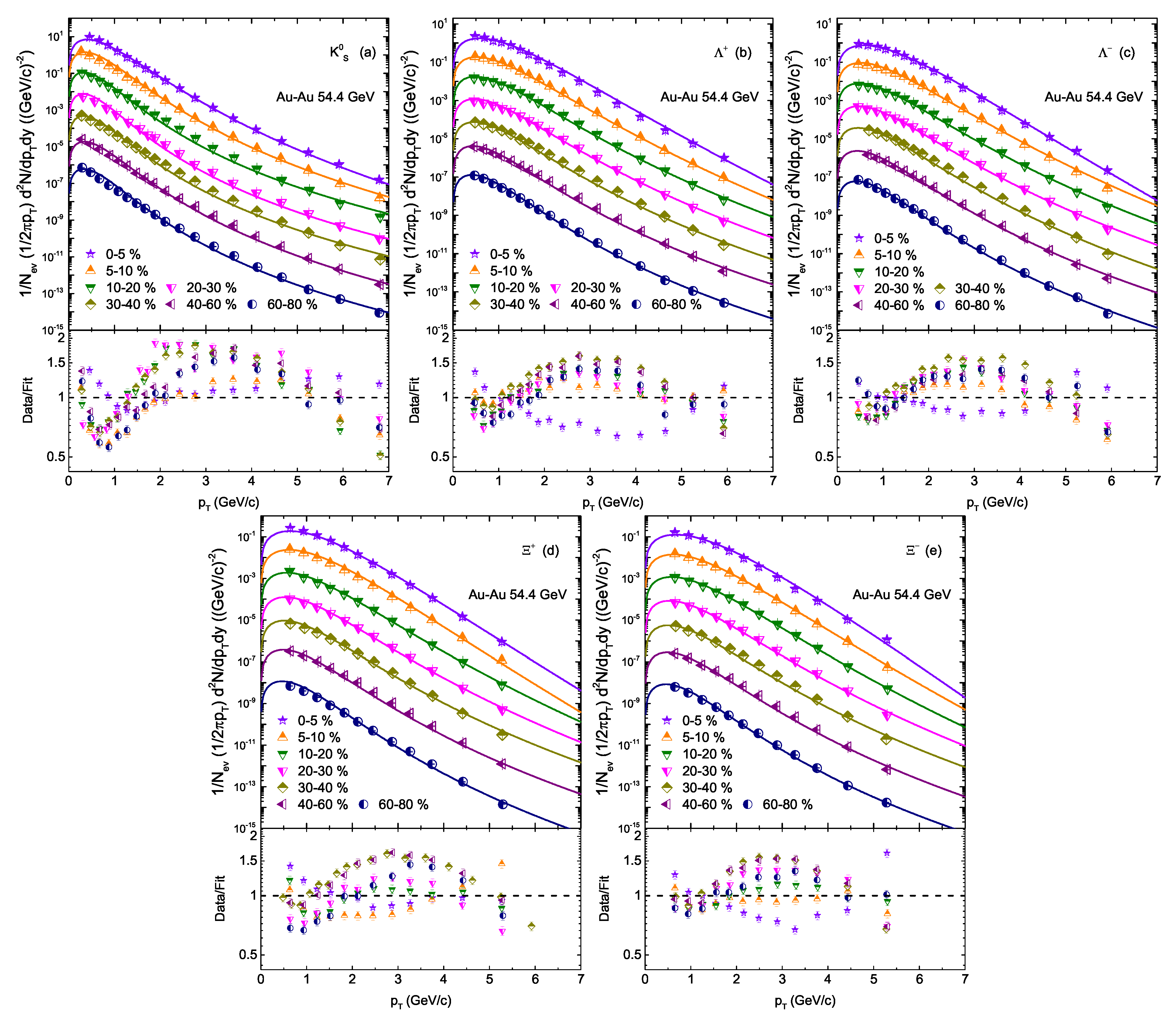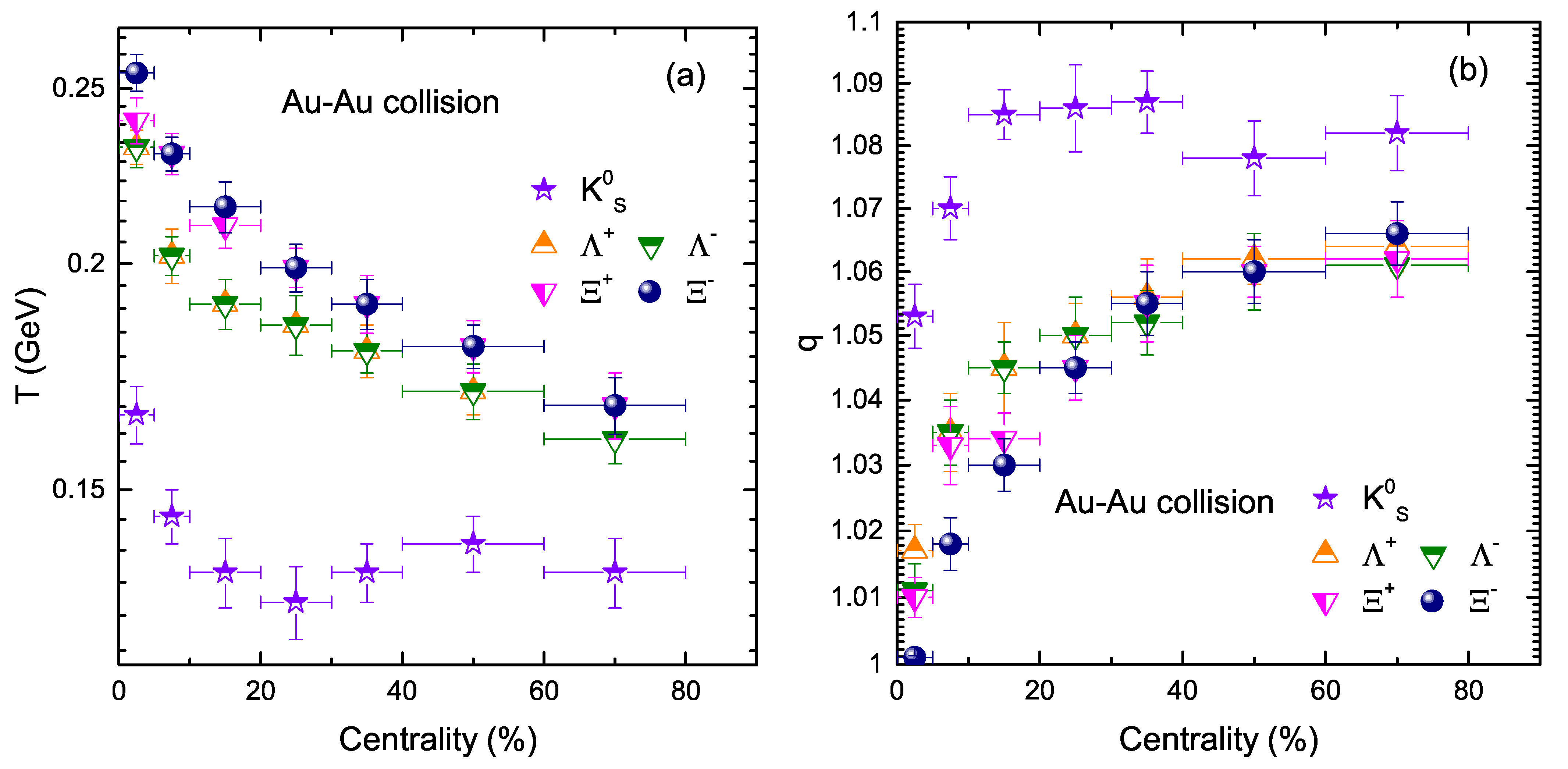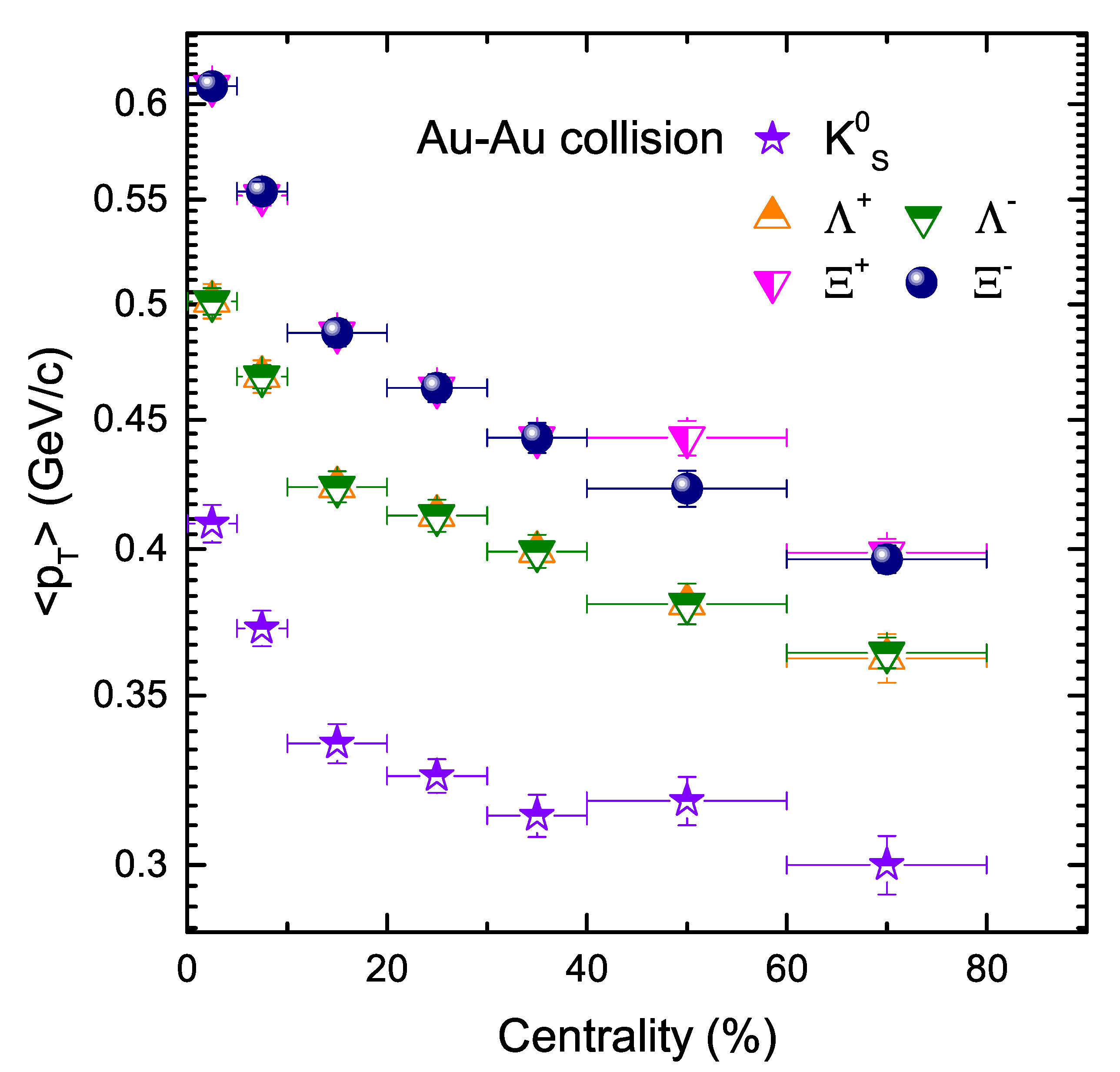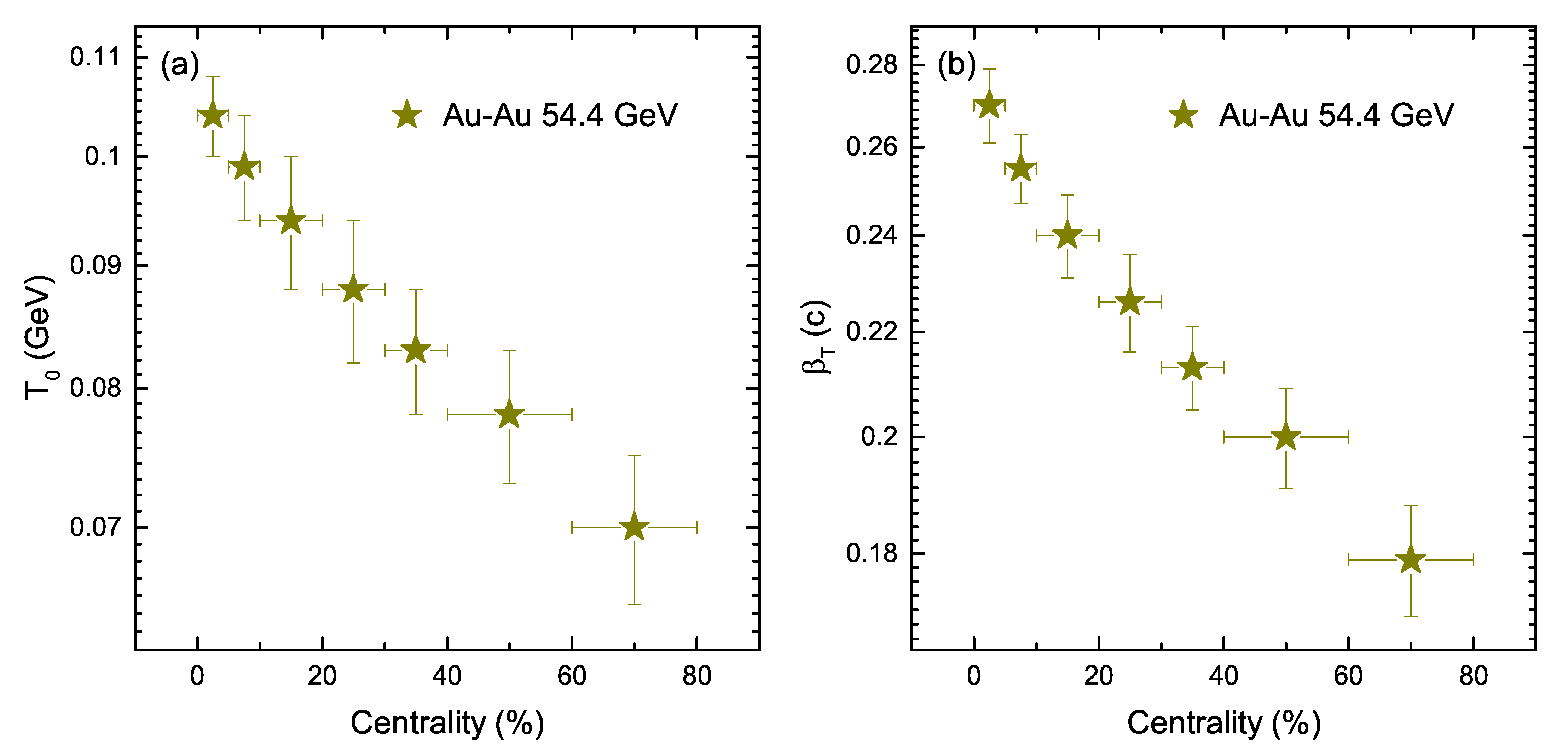Study of Bulk Properties of Strange Particles in Au+Au Collisions at
Abstract
1. Introduction
2. Methods and Models
3. Results and Discussion
4. Conclusions
- The transverse momentum spectra of various strange hadrons , () and () are analyzed at mid-rapidity (y) in different centrality intervals from Au+Au collisions at = 54.4 GeV. The Tsallis-like distribution is used to analyze the spectra of these strange hadrons. The model results showed an agreement with the experimental data from the STAR experiment;
- The centrality dependence of entropy index q is studied for , () and () in Au+Au collisions. The q-value of () and () in central collisions is close to unity, which indicates a rapid approach of the system to equilibrium, while towards periphery, the system deviates far from the equilibrium state. On the other hand, does not show strong centrality dependence in q-value, indicating that it hardly interacts with the created medium during high energy heavy-ion collisions. Moreover, the mean () is observed to show a decreasing trend from central to peripheral collisions indicating that, in central collisions, the amount of momentum gained by the system and multiple scatterings is larger in comparison to the peripheral collisions, and the radial flow is more pronounced;
- The effective temperature T, mean transverse momentum and the entropy q are mass dependent and they increase with the mass of the particle. Furthermore, the isotropic assumption in the rest frame of emission is interpreted in the calculation from to and using the Monte-Carlo method;
- The freeze-out temperature and transverse velocity are extracted using an alternative method, and they are observed to be decreasing from the central to peripheral collisions. The reason for this behavior is that the degree of excitation of the system in central collisions is much higher than that of peripheral collisions. and it could also be due to the large number of participating nucleons that are experiencing a stronger squeeze as more violent reaction takes place and a high pressure gradient is produced. This results in a rapid expansion of the system in central collisions as compared to peripheral collisions;
- The correlation between mean transverse momentum and effective temperature T, and entropy q and effective temperature T, are reported. The former correlation is positive while the latter correlation is negative, and they show the early equilibrium state of the central collisions as well as for massive particles;
- Finally, the presented results are consistent with our previous results in Ref. [65] with the BEAM energy Scan, in which we analyzed the light nuclei and obtained a decreasing trend of T as well as from central to peripheral collisions. However, there is an inconsistency in the present results with Ref. [36], where the light nuclei are analyzed using the Blast-Wave model. However, the same model also gives different results if we use different methods of extraction of the parameters, as well as if the limits and conditions applied to the model are different [20,42].
Author Contributions
Funding
Institutional Review Board Statement
Informed Consent Statement
Data Availability Statement
Acknowledgments
Conflicts of Interest
References
- Kittiratpattana, A.; Wondrak, M.F.; Hamzic, M.; Bleicher, M.; Limphirat, A.; Herold, C. Modeling (anti)deuteron formation at RHIC with a geometric coalescence model. Phys. Scr. 2021, 96, 124002. [Google Scholar] [CrossRef]
- Scheibl, R.; Heinz, U. Coalescence and flow in ultrarelativistic heavy ion collisions. Phys. Rev. C 1999, 59, 1585–1602. [Google Scholar] [CrossRef]
- De Curtis, S.; Pettini, G. Chiral phase transition in QCD for finite temperature and density. Nucl. Phys. A 1991, 525, 171–174. [Google Scholar] [CrossRef]
- Masayuki, A.; Koichi, Y. Chiral restoration at finite density and temperature. Nucl. Phys. A 1989, 504, 668–684. [Google Scholar] [CrossRef]
- Stephanov, M.A. QCD phase diagram and the critical point. Int. J. Mod. Phys. A 2005, 20, 4387–4392. [Google Scholar] [CrossRef]
- Stephanov, M. QCD Phase Diagram and the Critical Point. Prog. Theor. Phys. Suppl. 2004, 153, 139–156. [Google Scholar] [CrossRef]
- Aoki, Y.; Endrodi, G.; Fodor, Z.; Katz, S.D.; Szabo, K.K. The Order of the quantum chromodynamics transition predicted by the standard model of particle physics. Nature 2006, 443, 675–678. [Google Scholar] [CrossRef]
- Hansen, M.T.; Sharpe, S.R. Threshold expansion of the three-particle quantization condition. Phys. Rev. D 2016, 93, 096006, Erratum in Phys. Rev. D 2017, 96, 039901. [Google Scholar] [CrossRef]
- Bowman, E.S.; Kapusta, J.I. Critical Points in the Linear Sigma Model with Quarks. Phys. Rev. C 2009, 79, 015202. [Google Scholar] [CrossRef]
- Ismail, A.H.; Waseem, H.M.; Ishtiaq, M.; Jamal, S.S.; Khan, M. Quantum Spin Half Algebra and Generalized Megrelishvili Protocol for Confidentiality of Digital Images. Int. J. Theor. Phys. 2021, 60, 1720–1741. [Google Scholar] [CrossRef]
- Fodor, Z.; Katz, S.D. Critical point of QCD at finite T and mu, lattice results for physical quark masses. JHEP 2004, 04, 050. [Google Scholar] [CrossRef]
- Gavai, R.V.; Gupta, S. QCD at finite chemical potential with six time slices. Phys. Rev. D 2008, 78, 114503. [Google Scholar] [CrossRef]
- Rao, S.; Sievert, M.; Noronha-Hostler, J. Baseline predictions of elliptic flow and fluctuations for the RHIC Beam Energy Scan using response coefficients. Phys. Rev. C 2021, 103, 034910. [Google Scholar] [CrossRef]
- Tokarev, M.; Kechechyan, A.; Zborovský, I. Validation of z-scaling for negative particle production in Au + Au collisions from BES-I at STAR. Nucl. Phys. A 2020, 993, 121646. [Google Scholar] [CrossRef]
- Adam, J.; Adamczyk, L.; Adams, J.R.; Adkins, J.K.; Agakishiev, G.; Aggarwal, M.M.; Ahammed, Z.; Alekseev, I.; Anderson, D.M.; Aoyama, R.; et al. Strange hadron production in Au+Au collisions at = 7.7, 11.5, 19.6, 27, and 39 GeV. Phys. Rev. C 2020, 102, 034909. [Google Scholar] [CrossRef]
- Adam, J.; Adamczyk, L.; Adams, J.R.; Adkins, J.K.; Agakishiev, G.; Aggarwal, M.M.; Ahammed, Z.; Alekseev, I.; Anderson, D.M.; Aparin, A.; et al. Bulk properties of the system formed in Au+Au collisions at = 14.5 GeV at the BNL STAR detector. Phys. Rev. C 2020, 101, 024905. [Google Scholar] [CrossRef]
- Ashraf, M.U. Measurements of strange hadrons K(S)(0), Λ and Ξ from Au+Au collisions at = 14.5 GeV in STAR. J. Phys. Conf. Ser. 2016, 668, 012095. [Google Scholar] [CrossRef]
- Ashraf, M.U. Recent Results on Strangeness Production from STAR. Nucl. Phys. A 2021, 1005, 121815. [Google Scholar] [CrossRef]
- Adams, J.; Aggarwal, M.M.; Ahammed, Z.; Amonett, J.; Anderson, B.D.; Arkhipkin, D.; Averichev, G.S.; Badyal, S.K.; Bai, Y.; Balewski, J.; et al. Experimental and theoretical challenges in the search for the quark gluon plasma: The STAR Collaboration’s critical assessment of the evidence from RHIC collisions. Nucl. Phys. A 2005, 757, 102–183. [Google Scholar] [CrossRef]
- Adamczyk, L.; Adkins, J.K.; Agakishiev, G.; Aggarwal, M.M.; Ahammed, Z.; Ajitanand, N.N.; Alekseev, I.; Anderson, D.M.; Aoyama, R.; Aparin, A.; et al. Bulk Properties of the Medium Produced in Relativistic Heavy-Ion Collisions from the Beam Energy Scan Program. Phys. Rev. C 2017, 96, 044904. [Google Scholar] [CrossRef]
- Wheaton, S.; Cleymans, J. THERMUS: A Thermal model package for ROOT. Comput. Phys. Commun. 2009, 180, 84–106. [Google Scholar] [CrossRef]
- Andronic, A.; Beutler, F.; Braun-Munzinger, P.; Redlich, K.; Stachel, J. Thermal description of hadron production in e+e- collisions revisited. Phys. Lett. B 2009, 675, 312–318. [Google Scholar] [CrossRef]
- Abelev, B.I.; Aggarwal, M.M.; Ahammed, Z.; Anderson, B.D.; Arkhipkin, D.; Averichev, G.S.; Bai, Y.; Balewski, J.; Barannikova, O.; Barnby, L.S.; et al. Systematic Measurements of Identified Particle Spectra in pp,d+ Au and Au+Au Collisions from STAR. Phys. Rev. C 2009, 79, 034909. [Google Scholar] [CrossRef]
- Schnedermann, E.; Sollfrank, J.; Heinz, U.W. Thermal phenomenology of hadrons from 200-A/GeV S+S collisions. Phys. Rev. C 1993, 48, 2462–2475. [Google Scholar] [CrossRef] [PubMed]
- Tang, Z.; Xu, Y.; Ruan, L.; van Buren, G.; Wang, F.; Xu, Z. Spectra and radial flow at RHIC with Tsallis statistics in a Blast-Wave description. Phys. Rev. C 2009, 79, 051901. [Google Scholar] [CrossRef]
- Chatterjee, S.; Das, S.; Kumar, L.; Mishra, D.; Mohanty, B.; Sahoo, R.; Sharma, N. Freeze-Out Parameters in Heavy-Ion Collisions at AGS, SPS, RHIC, and LHC Energies. Adv. High Energy Phys. 2015, 2015, 349013. [Google Scholar] [CrossRef]
- Chatterjee, S.; Mohanty, B.; Singh, R. Freezeout hypersurface at energies available at the CERN Large Hadron Collider from particle spectra: Flavor and centrality dependence. Phys. Rev. C 2015, 92, 024917. [Google Scholar] [CrossRef]
- Waqas, M.; Peng, G.X.; Liu, F.H. An evidence of triple kinetic freezeout scenario observed in all centrality intervals in Cu–Cu, Au–Au and Pb–Pb collisions at high energies. J. Phys. G 2021, 48, 075108. [Google Scholar] [CrossRef]
- Waqas, M.; Liu, F.H.; Wang, R.Q.; Siddique, I. Energy scan/dependence of kinetic freeze-out scenarios of multi-strange and other identified particles in central nucleus-nucleus collisions. Eur. Phys. J. A 2020, 56, 188. [Google Scholar] [CrossRef]
- Thakur, D.; Tripathy, S.; Garg, P.; Sahoo, R.; Cleymans, J. Indication of a Differential Freeze-out in Proton-Proton and Heavy-Ion Collisions at RHIC and LHC energies. Adv. High Energy Phys. 2016, 2016, 4149352. [Google Scholar] [CrossRef]
- Chatterjee, S.; Mohanty, B. Production of Light Nuclei in Heavy Ion Collisions Within Multiple Freezeout Scenario. Phys. Rev. C 2014, 90, 034908. [Google Scholar] [CrossRef]
- Waqas, M.; Peng, G.X.; Wazir, Z.; Lao, H. Analysis of kinetic freeze-out temperature and transverse flow velocity in nucleus–nucleus and proton–proton collisions at same center-of-mass energy. Int. J. Mod. Phys. E 2021, 30, 2150061. [Google Scholar] [CrossRef]
- Lao, H.L.; Liu, F.H.; Ma, B.Q. Analyzing Transverse Momentum Spectra of Pions, Kaons and Protons in p–p, p–A and A–A Collisions via the Blast-Wave Model with Fluctuations. Entropy 2021, 23, 803. [Google Scholar] [CrossRef]
- Waqas, M.; Peng, G.X.; Liu, F.H.; Wazir, Z. Effects of coalescence and isospin symmetry on the freezeout of light nuclei and their anti-particles. Sci. Rep. 2021, 11, 20252. [Google Scholar] [CrossRef] [PubMed]
- Kumar, L. Systematics of Kinetic Freeze-out Properties in High Energy Collisions from STAR. Nucl. Phys. A 2014, 931, 1114–1119. [Google Scholar] [CrossRef]
- Waqas, M.; Peng, G.X. Study of Proton, Deuteron, and Triton at 54.4 GeV. Adv. High Energy Phys. 2021, 2021, 6674470. [Google Scholar] [CrossRef]
- Waqas, M.; Liu, F.H. Initial, effective, and kinetic freeze-out temperatures from transverse momentum spectra in high-energy proton(deuteron)–nucleus and nucleus–nucleus collisions. Eur. Phys. J. Plus 2020, 135, 147. [Google Scholar] [CrossRef]
- Li, L.L.; Liu, F.H.; Waqas, M.; Al-Yusufi, R.; Mujear, A. Excitation functions of related parameters from transverse momentum (mass) spectra in high energy collisions. Adv. High Energy Phys. 2020, 2020, 5356705. [Google Scholar] [CrossRef]
- Haj Ismail, A. Monte Carlo simulation of the cosmic muon charge ratio. Kuwait J. Sci. 2022, 49, 1–8. [Google Scholar] [CrossRef]
- Waqas, M.; Liu, F.H. Centrality dependence of kinetic freeze-out temperature and transverse flow velocity in high energy nuclear collisions. Indian J. Phys. 2022, 96, 1217–1235. [Google Scholar] [CrossRef]
- Ajaz, M.; Khubrani, A.M.; Waqas, M.; Haj Ismail, A.A.K.; Dawi, E.A. Collective properties of hadrons in comparison of models prediction in pp collisions at 7 TeV. Results Phys. 2022, 36, 105433. [Google Scholar] [CrossRef]
- Waqas, M.; Li, B.C. Kinetic freeze-out temperature and transverse flow velocity in Au-Au collisions at RHIC-BES energies. Adv. High Energy Phys. 2020, 2020, 1787183. [Google Scholar] [CrossRef]
- Hagedorn, R. Multiplicities, pT Distributions and the Expected Hadron → Quark - Gluon Phase Transition. Riv. Nuovo Cim. 1983, 6N10, 1–50. [Google Scholar] [CrossRef]
- Cleymans, J.; Worku, D. Relativistic Thermodynamics: Transverse Momentum Distributions in High-Energy Physics. Eur. Phys. J. A 2012, 48, 160. [Google Scholar] [CrossRef]
- Ajaz, M.; Waqas, M.; Peng, G.X.; Yasin, Z.; Younis, H.; Ismail, A.A.K.H. Study of pT spectra of light particles using modified Hagedorn function and cosmic rays Monte Carlo event generators in proton–proton collisions at = 900 GeV. Eur. Phys. J. Plus 2022, 137, 52. [Google Scholar] [CrossRef]
- Cleymans, J.; Oeschler, H.; Redlich, K.; Wheaton, S. Comparison of chemical freeze-out criteria in heavy-ion collisions. Phys. Rev. C 2006, 73, 034905. [Google Scholar] [CrossRef]
- Adak, R.P.; Das, S.; Ghosh, S.K.; Ray, R.; Samanta, S. Centrality dependence of chemical freeze-out parameters from net-proton and net-charge fluctuations using a hadron resonance gas model. Phys. Rev. C 2017, 96, 014902. [Google Scholar] [CrossRef]
- Ajaz, M.; Ahmed, A.; Wazir, Z.; Shehzadi, R.; Younis, H.; Khan, G.; Khan, R.; Ali, S.; Waqas, M.; Yang, P.P.; et al. Centrality dependence of PT distributions and nuclear modification factor of charged particles in Pb–Pb interactions at SNN = 2.76 TeV. Results Phys. 2021, 30, 104790. [Google Scholar] [CrossRef]
- Uddin, S.; Ahmad, J.S.; Bashir, W.; Bhat, R.A. A Unified Approach towards Describing Rapidity and Transverse Momentum Distributions in Thermal Freeze-Out Model. J. Phys. G 2012, 39, 015012. [Google Scholar] [CrossRef]
- Yang, P.P.; Ajaz, M.; Waqas, M.; Liu, F.H.; Suleymanov, M.K. Pseudorapidity dependence of the pT spectra of charged hadrons in pp collisions at = 0.9 and 2.36 TeV. J. Phys. G 2022, 49, 055110. [Google Scholar] [CrossRef]
- Tsallis, C. Possible Generalization of Boltzmann-Gibbs Statistics. J. Statist. Phys. 1988, 52, 479–487. [Google Scholar] [CrossRef]
- Biro, T.S.; Purcsel, G.; Urmossy, K. Non-Extensive Approach to Quark Matter. Eur. Phys. J. A 2009, 40, 325–340. [Google Scholar] [CrossRef]
- Cleymans, J.; Wellington Paradza, M. Tsallis Statistics in High Energy Physics: Chemical and Thermal Freeze-Outs. Physics 2020, 2, 654–664. [Google Scholar] [CrossRef]
- Zhang, X.H.; Gao, Y.Q.; Liu, F.H.; Olimov, K.K. Thermal Freeze-Out Parameters and Pseudoentropy from Charged Hadron Spectra in High-Energy Collisions. Adv. High Energy Phys. 2022, 2022, 7499093. [Google Scholar] [CrossRef]
- Su, Y.; Sun, Y.; Zhang, Y.; Chen, X. Non-extensive statistical distributions of charmed meson production in Pb-Pb and pp() collisions. Nucl. Sci. Tech. 2021, 32, 108. [Google Scholar] [CrossRef]
- Li, L.L.; Liu, F.H. Kinetic Freeze-Out Properties from Transverse Momentum Spectra of Pions in High Energy Proton-Proton Collisions. Physics 2020, 2, 277–308. [Google Scholar] [CrossRef]
- Wei, H.R.; Liu, F.H.; Lacey, R.A. Disentangling random thermal motion of particles and collective expansion of source from transverse momentum spectra in high energy collisions. J. Phys. G 2016, 43, 125102. [Google Scholar] [CrossRef]
- Wei, H.R.; Liu, F.H.; Lacey, R.A. Kinetic freeze-out temperature and flow velocity extracted from transverse momentum spectra of final-state light flavor particles produced in collisions at RHIC and LHC. Eur. Phys. J. A 2016, 52, 102. [Google Scholar] [CrossRef]
- Lao, H.L.; Wei, H.R.; Liu, F.H.; Lacey, R.A. An evidence of mass-dependent differential kinetic freeze-out scenario observed in Pb-Pb collisions at 2.76 TeV. Eur. Phys. J. A 2016, 52, 203. [Google Scholar] [CrossRef]
- Waqas, M.; Liu, F.H.; Wazir, Z. Dependence of temperatures and kinetic freeze-out volume on centrality in Au-Au and Pb-Pb collisions at high energy. Adv. High Energy Phys. 2020, 2020, 8198126. [Google Scholar] [CrossRef]
- Waqas, M.; Liu, F.H.; Li, L.L.; Alfanda, H.M. Effective (kinetic freeze-out) temperature, transverse flow velocity and kinetic freeze-out volume in high energy collisions. Nucl. Sci. Tech. 2020, 31, 109. [Google Scholar] [CrossRef]
- Heinz, U.W. Concepts of heavy ion physics. In Proceedings of the 2nd CERN-CLAF School of High Energy Physics, Guixols, Spain, 30 May–12 June 2004; pp. 165–238. [Google Scholar]
- Adler, S.S. Identified charged particle spectra and yields in Au+Au collisions at S(NN)**1/2 = 200-GeV. Phys. Rev. C 2004, 69, 034909. [Google Scholar] [CrossRef]
- Takeuchi, S.; Murase, K.; Hirano, T.; Huovinen, P.; Nara, Y. Effects of hadronic rescattering on multistrange hadrons in high-energy nuclear collisions. Phys. Rev. C 2015, 92, 044907. [Google Scholar] [CrossRef]
- Waqas, M.; Peng, G.X.; Ajaz, M.; Ismail Haj, A.A.K.; Wazir, Z.; Li, L.L. Extraction of different temperatures and kinetic freeze-out volume in high energy collisions. J. Phys. G 2022, 49, 095102. [Google Scholar] [CrossRef]






| Collision | Particle | Centrality | T (GeV) | q | /dof | |
|---|---|---|---|---|---|---|
| Au-Au 54.4 GeV | 0–5% | 111/16 | ||||
| 5–10% | 30/17 | |||||
| 10–20% | 110/17 | |||||
| 20–30% | 44/17 | |||||
| 30–40% | 139/17 | |||||
| 40–60% | 61/17 | |||||
| 60–80% | 58/17 | |||||
| Au-Au 54.4 GeV | 0–5% | 61/15 | ||||
| 5–10% | 70/15 | |||||
| 10–20% | 25/15 | |||||
| 20–30% | 82/15 | |||||
| 30–40% | 37/15 | |||||
| 40–60% | 43/15 | |||||
| 60-80% | 60/15 | |||||
| Au-Au 54.4 GeV | 0–5% | 25/15 | ||||
| 5–10% | 28/15 | |||||
| 10–20% | 98/15 | |||||
| 20–30% | 95/15 | |||||
| 30–40% | 70/15 | |||||
| 40–60% | 32/15 | |||||
| 60–80% | 84/15 | |||||
| Au-Au 54.4 GeV | 0–5% | 31/10 | ||||
| 5–10% | 18/10 | |||||
| 10–20% | 87/10 | |||||
| 20–30% | 122/10 | |||||
| 30–40% | 75/10 | |||||
| 40–60% | 82/10 | |||||
| 60-80% | 39/10 | |||||
| Au-Au 54.4 GeV | 0–5% | 28/10 | ||||
| 5–10% | 55/10 | |||||
| 10–20% | 93/10 | |||||
| 20–30% | 39/10 | |||||
| 30–40% | 68/10 | |||||
| 40–60% | 76/10 | |||||
| 60–80% | 46/10 |
| Figure | Collision | Centrality | Intercept | Slope | |
|---|---|---|---|---|---|
| Figure 4a | Au-Au | 0–5% | |||
| 5–10% | |||||
| 10–20% | |||||
| 20–30% | |||||
| 30–40% | 5 | ||||
| 40–60% | 16 | ||||
| 60–80% | 20 |
Publisher’s Note: MDPI stays neutral with regard to jurisdictional claims in published maps and institutional affiliations. |
© 2022 by the authors. Licensee MDPI, Basel, Switzerland. This article is an open access article distributed under the terms and conditions of the Creative Commons Attribution (CC BY) license (https://creativecommons.org/licenses/by/4.0/).
Share and Cite
Li, L.-L.; Haj Ismail, A.A.K.
Study of Bulk Properties of Strange Particles in Au+Au Collisions at
Li L-L, Haj Ismail AAK.
Study of Bulk Properties of Strange Particles in Au+Au Collisions at
Li, Li-Li, and Abd Al Karim Haj Ismail.
2022. "Study of Bulk Properties of Strange Particles in Au+Au Collisions at
Li, L.-L., & Haj Ismail, A. A. K.
(2022). Study of Bulk Properties of Strange Particles in Au+Au Collisions at








